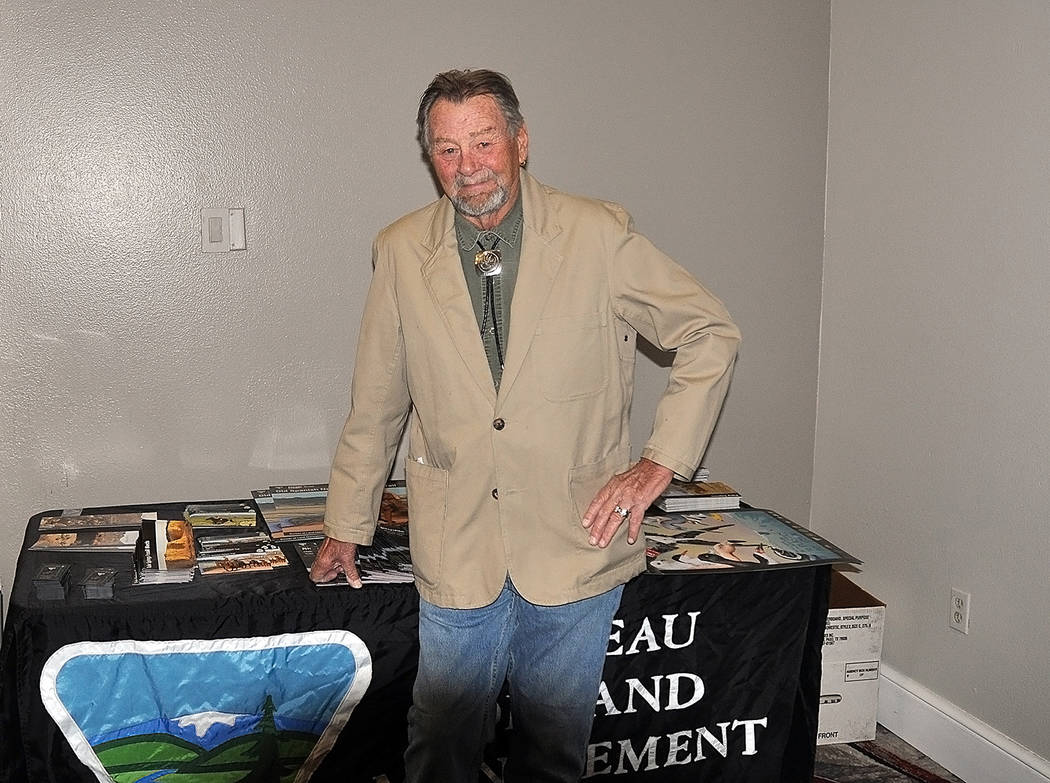
Back in the early 20th century, it would be accurate to consider the desolate and isolated town of Rhyolite was on the verge of becoming a “Boomtown” when two prospectors, Shorty Harris and Ed Cross discovered gold there in 1904.
Roughly four years later, in 1908, the estimated population rose upward of 8,000 residents, but residents began to leave when gold production levels fell drastically.
By 1920, the estimated population of Rhyolite was 14.
Fast forward 100 years, to 2020, Rhyolite has just one resident by the name of Karl Olson, who is now considered the official caretaker of the town roughly 80 miles northwest of Pahrump, and just a 10-minute drive from the town of Beatty.
On Saturday, March 7, Olson was recognized for his efforts by the Nevada Archaeological Association during its 49th annual Banquet Awards Dinner Meeting at the Pahrump Nugget.
“I became the caretaker of Rhyolite approximately four and a half years ago,” Olson said. “Being the caretaker, requires taking care of the buildings as a watchman and making sure that nobody pilfers the historical relics that are there. I also give tours to professional groups, and within the last week, I gave one to the University of Arizona and I gave one to a huge private photography group from California who stayed in Beatty and did a lot of stuff. At the time, it was thought that Rhyolite was actually going to be the capital of Nevada, and that’s how it took off.”
Due to its historical significance, Olson said Rhyolite draws tens of thousands of tourists each year to inspect what’s left of the town.
The points of interest in Rhyolite include the Las Vegas and Tonopah Depot, the Cook Bank Building ruins and the Rhyolite School ruins.
Olson did note that there is one point of interest that attracts people the most, Tom Kelly’s Bottle House, erected in 1906.
“Tom Kelly built the three-room bottle house to raffle it off,” he said. “The house served as a residence to the winning family for many years. The train station and the bank are also very popular among the tourists.
“We put a counter out there that counts cars, and we took the vehicular traffic and compared it with our sign-in sheets, and in three months we had 89,000 people come through. It’s probably one of the biggest tourist attractions in the whole Beatty area. By far, I think one of the most outstanding features of our county is Rhyolite, where the population is just me.”
As the caretaker of Rhyolite, Olson also worked to map the area, including all of the drivable roads around Beatty, where it earned a designation with the Nevada Off-Road Vehicle Association, which is bringing additional tourists to the region.
“It’s starting to build more tourism in our town,” he said. “We are starting to get Jeep groups that are coming and staying, so I really wanted to let people know that. Because of the internet, a lot of tourists are now staying in Beatty, because it’s more reasonably priced. We also get tons of European visitors because of its proximity to Death Valley, which is about 45 miles from the Furnace Creek Visitor Center. In fact, some stay at the Furnace Creek Inn, the Furnace Creek Resort, and the campgrounds.”
Mark Giambastiani, the president of the Nevada Archaeological Association, spoke about the organization and the meeting.
“The Nevada Archaeological Association started back in 1972,” he said. “Part of our mission is to foster public awareness and avocational interest in archaeology. Right now we have about 130 members. It varies from year to year but we usually get 70-to-80 attendees each meeting. We try to hold our ceremony in Southern and Northern Nevada every year, where we switch off. Next year in Tonopah will be our 50th anniversary.”
Additionally, Giambastiani lauded Olson’s work as caretaker and watchman of Rhyolite.
“He is the only resident of Rhyolite, and individuals and families can visit Rhyolite at their own leisure,” he said. “It’s on public land and it’s managed by the Bureau of Land Management, so there are some interpretive trails and brochures you can get out there. There’s a bunch of old historical buildings to check out and a lot of interesting history there. It’s very cool.”
Meanwhile, Olson said his recognition during the meeting came as a surprise to him.
“They just called me and told me to appear, but they didn’t tell me too much about it, and I was really pleasantly surprised,” he said. “I am not a native Nevadan, because I actually have a home in Washington State, but I spend most of my time here.”
To learn more about becoming a member of the Nevada Archaeological Association, head to www.nvarch.org.
Contact reporter Selwyn Harris at sharris@pvtimes.com. On Twitter: @pvtimes